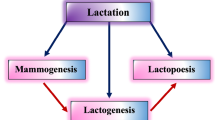Summary
The phospholipid (PL) content of human milk, cow's milk, and various infant formulas was determined by recently developed high performance liquid chromatography (6). As the examinations promised, the content of phosphatidylinositol (PI), phosphatidylethanolamine (PE), phosphatidylcholin (PC), and sphingomyelin (SP) was not changed by homogenization and pasteurization of cow's milk. Levels of phosphatidylglycerol (PG) were below the detection limit. Furthermore it has been proved that human milk and cow's milk are more or less identical in PL content.
Some of the PL in human milk varies during the course of pregnancy and postpartum. PI, PC, and SP content in the prepartum mammarial secretion lies above the average content of mature human milk after delivery. Before the contractions start, all the PL examined show a more or less considerable decrease. PC drops to 30 % of the value at the beginning of the examination six weeks before delivery. PG contents are very low throughout the whole period. Contrary to the others, PC content recovers three weeks after delivery, which may be the result of the endogenous surfactant replacement system.
To compare PL content with human milk and cow's milk, 13 different infant formulas have been examined. There are considerable differences to be found in and among adapted milk, partially adapted milk, and special formulas. None of the PL examined could be found in all the infant formulas, where PG content was usually low, except in some Milupa formulas. PE and PI were not to be found in some special formulas. Most of the formulas contain high amounts of SP, in some cases higher than the amount of PC. To a certain extent infant formulas contain a considerably greater amount of other PL concentrations than human milk and cow's milk. In most of the formulas examined the PL content is generally so high, that it can be used as a source of PL for the newborn.
Zusammenfassung
Mit Hilfe einer speziell hierfür entwickelten (6) Hochdruckflüssigkeitschromatographie-Methode (HPLC) wurde der Phospholipidgehalt (PL) von Frauenmilch, Kuhmilch und verschiedenen Säuglingsnahrungen bestimmt. Die Untersuchungen zeigen, daß der Gehalt an Phosphatidylinositol (PI), Phosphatidyläthanolamin (PE), Phosphatidylcholin (PC) und Sphingomyelin (SP) durch Homogenisieren und Pasteurisieren von Kuhmilch nicht verändert wird. Der Gehalt an Phosphatidylglycerol (PG) liegt hier, wie bei der Frauenmilch, unter der Nachweisgrenze. Auch bei den anderen untersuchten PL konnten zwischen Frauen- und Kuhmilch keine nennenswerten Unterschiede festgestellt werden.
Der Gehalt einiger PL verändert sich im Verlauf der Spätschwangerschaft und der Post-partum-Periode charakteristisch. So liegt der Gehalt an PI, PC und SP in der Vormilch deutlich über dem Gehalt reifer Frauenmilch. Bereits vor Beginn der Wehen zeigen alle PL einen mehr oder weniger scharfen Abfall. So verliert Vormilch vor der Geburt 70 % des Gehaltes, den PL-Proben sechs Wochen vor der Geburt zeigen. Die PG-Gehalte sind allgemein in der gesamten Beobachtungsperiode sehr niedrig. Im Gegensatz zu den anderen Parametern erholt sich der PC-Gehalt drei Wochen nach der Geburt wieder, was als Ausdruck eines endogenen Surfactant-Regelmechanismus betrachtet werden kann.
Weiterhin wurden 13 verschiedene Säuglingsnahrungen im Vergleich mit Kuhmilch und Frauenmilch untersucht. Dabei wurden teilweise erhebliche Unterschiede zwischen adaptierter Milch, teilweise adaptierter Milch und Spezialnahrungen, aber auch innerhalb dieser Gruppen, gefunden. Keines der bestimmten PL konnte in allen Säuglingsnahrungen nachgewiesen werden. Mit Ausnahme einiger Milupa-Säuglingsnahrungen war der PG-Gehalt allgemein niedrig. PE und PI wurden nur in einigen Spezialnahrungen nicht gefunden. Die meisten Säuglingsnahrungen enthalten hohe Gehalte an SP, die teilweise höher als der Gehalt an PC liegen.
Allgemein kann gesagt werden, daß die untersuchten Säuglingsnahrungen z.T. wesentlich andere Phospholipidmuster als Frauen- und Kuhmilch aufweisen und daß zwischen einzelnen Säuglingsnahrungen erhebliche Unterschiede in der Zusammensetzung bestehen. In den meisten der untersuchten Nahrungen ist der Phospholipidgehalt so hoch, daß er durchaus als Phospholipidquelle für das Neugeborene genutzt werden kann.
Similar content being viewed by others
References
Bitman J, Freed LM, Neville MC, Wood DL, Hamosh P, Hamosh M (1986) Lipid composition of prepartum human mammary secretion and postpartum milk. J Ped Gastr Nutr 5:608–615
Brätter P (personal information and publication of the method), Brätter P, Gehrkes B, Rösik U, Tomiak A (1988) Speciation of trace elements in human milk and milk formulas. In: Brätter P, Schramel P (eds) Trace elements analysis in medicine and biology. Walter de Gruyter, Berlin New York 5 (in print)
Harzer G, Haug M, Bindels JG (1986) Biochemistry of human milk in early lactation. Z Ernährungswiss 25:77–90
Heinze T, Kynast G, Dudenhausen JW, Schmitz C, Saling E (1988) Quantitative determination of phospholipids in amniotic fluid by high performance liquid chromatography. Chromatographia 25:497–503
Jobe A (1988) The role of surfactant in neonatal adaptation. Seminars in Perinatology 12:113–123
Kynast G, Schmitz C (1988) Simplified quantitative determination of phospholipids in amniotic fluid, alveolar lavages and milk using high performance liquid chromatography (HPLC). J Perinat Med (in print)
Shapiro DL (1988) The future of surfactant replacement therapy. Seminars in Perinatology 12:259–260
Weaver TE, Whitsett JA (1988) Structure and function of pulmonary surfactant proteins. Seminars in Perinatology 12:213–220
Author information
Authors and Affiliations
Rights and permissions
About this article
Cite this article
Kynast, G., Schmitz, C. Determination of the phospholipid content of human milk, cow's milk and various infant formulas. Z Ernährungswiss 27, 252–265 (1988). https://doi.org/10.1007/BF02019514
Received:
Published:
Issue Date:
DOI: https://doi.org/10.1007/BF02019514




